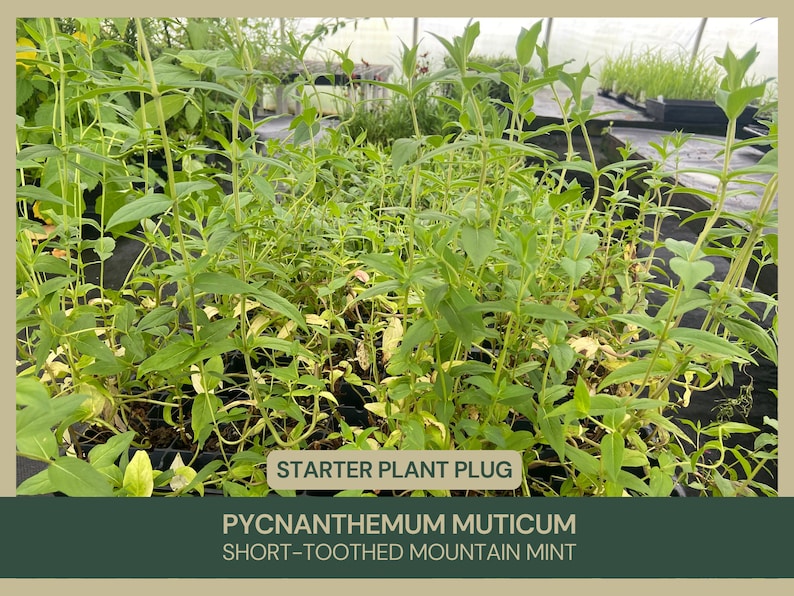
Pycnanthemum muticum
Common name: Short-toothed Mountain Mint
Clustered Mountain Mint: A Gardener's Guide to Growing Pycnanthemum Muticum
Pycnanthemum muticum, commonly known as Short-Toothed Mountain Mint, is a fragrant perennial known for its dense clusters of tiny white to lavender flowers and aromatic, silvery-green foliage. It typically grows 24-36 inches tall and spreads about 18-24 inches wide.
Easy to grow and maintain, making it perfect for both beginners and experienced gardeners.
Thrives in a variety of climates, adaptable to different environmental conditions.
Its blooms are not only visually appealing but also attract beneficial insects and pollinators, including bees and butterflies.
Plant Care
Proper care is essential for the thriving growth of Clustered Mountain Mint.
Sunlight: Flourishes in full sun, yet is capable of tolerating partial shade, offering versatility in garden placement.
Soil: Optimal growth is observed in well-drained, fertile soil, ideal for robust development.
Watering: Has moderate water needs but becomes drought-tolerant once established, easing long-term care.
Spacing: Space the plants 18-24 inches apart to ensure adequate room for growth and spreading.
Planting and Propagation
Planting and propagating Pycnanthemum muticum can enhance your garden's ecological value and aesthetic appeal.
Plant in spring or fall for best establishment.
Propagate by dividing the roots in spring or autumn.
Can also be grown from seed, but division is more straightforward.
Pests and Diseases
Clustered Mountain Mint is generally robust and resistant to pests and diseases.
Rarely troubled by pests; its strong scent is a natural deterrent.
Avoid root rot by ensuring good soil drainage.
Proper spacing helps maintain good air circulation and prevents most fungal issues.
Feeding and Fertilizing
Regular feeding is not typically necessary for Clustered Mountain Mint.
If grown in poor soil, a light application of all-purpose fertilizer in spring can promote growth.
Over-fertilizing can diminish the plant's fragrance and natural hardiness.
Enriching the soil with compost can provide adequate nutrients.
Seasonal Care
Adjusting care according to the seasons will help your Clustered Mountain Mint flourish.
In late fall, cut back the plant to help tidy the garden and encourage new growth in spring.
Mulch lightly in fall for winter protection, especially in colder climates.
Divide the plants every few years to maintain vigor and manage spread.
Plant Uses
Pycnanthemum muticum offers a variety of uses in the garden and beyond.
Perfect for creating a pollinator-friendly garden.
Can be used in fresh or dried floral arrangements for its attractive bracts and fragrance.
The leaves can be used to make herbal teas.
Varieties and Cultivars
While Pycnanthemum muticum is a specific species, exploring other mountain mint varieties can add diversity.
Other species, such as Pycnanthemum tenuifolium, offer similar benefits with slightly different foliage and growth habits.
Experiment with different species to enjoy a range of fragrances and flower forms.

Growing Tips and Tricks
Some additional tips can help you successfully grow and enjoy Clustered Mountain Mint.
Thrives in a sunny location with well-draining soil.
Tolerates a range of soil conditions, from dry to moist.
Regularly harvesting or deadheading can encourage fuller growth and more blooms.
Troubleshooting Common Problems
Addressing common issues early can keep your Clustered Mountain Mint healthy.
If plants appear weak or spindly, they may require more sunlight.
Overly wet soil can lead to root problems; ensure adequate drainage.
Control its spread by removing unwanted runners and seedlings.
Read our blogs for more gardening tips!




